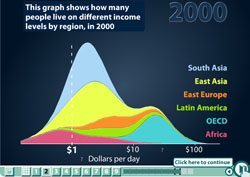The presenter is Hans Rosling, the founder of Gapminder, a non-profit organization in Sweeden dedicated to making visual information on global development publicly available. What's so beautiful about this presentation is the ease in which the visualizations help to immediately recognize complex trends and relationships in the data. No PhD in statistics required!

Gapminder is freely offering access to much of this data and visualizations. It has a tremendous potential to help teach the public, politicians, and academia about global trends currently at play in the world.
Watch the video! I guarantee you will learn something new about how the world is changing.
A Few Related Links:
Read an excellent article by Abhijit Vinayak Banerjee about how to effectively fight global poverty, including some excellent discussion and further thoughts here.
Tyler Cowen shares his thoughts on micro-finance.
Hattip Statistical Modeling, Causal Inference, and Social Science
1 comment:
Amazing stuff Bri! There's nothing like watching an entertaining video AND feeling like you're learning something. He makes an excellent point that there are not poor countries and rich countries but poor people and rich people.
I wonder if there's a way to connect that to the Solow model and convergence. Since institutions are the factor that distinguishes between conditional and absolute convergence, and, I assume, that those very rich people in the poor countries are politicians, military, high-powered business folk, they can get around the nasty institutions (trade barriers, restrictions on businesses starting and expansion, additional costs to protection) that make the distinction between economies needed. In other words, that the very rich and powerful in poor, restrictive countries live as if they are opperating in rich, free countries.
Is this a crazy idea or is there something to this?
Post a Comment